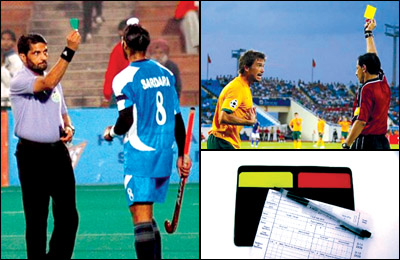Penalty cards used in sports
 When it comes to sports, judges and referees are important to
maintain fair play of the game and resolve any sort of clashes between
opposing sides. In order to ensure rules are followed and clashes don’t
occur, many forms of representation are used. For example, in motor car
races, flags are used to convey certain messages. When it comes to sports, judges and referees are important to
maintain fair play of the game and resolve any sort of clashes between
opposing sides. In order to ensure rules are followed and clashes don’t
occur, many forms of representation are used. For example, in motor car
races, flags are used to convey certain messages.
Likewise, coloured cards are used in many sports in order to give a
message in a way which is visible to everybody including the players,
spectators and media. The two most widely used cards are the yellow card
and the red card although a couple of others are also used. You must
have seen such cards being widely used in football matches. Let’s look
at the significance of these cards in the sports in which they are used.
The Yellow Card
Generally, a yellow card is used in a sport to warn a player that his
or her conduct is unacceptable and if that is continued, a certain level
of punishment will be given.
Where football is concerned, once a yellow card has been shown to a
player, the referee records it in a notebook; this is known as booking.
Once a yellow card is shown, the player can still continue playing, but
if the second yellow card is shown, it will be followed by a red card,
and the player has to leave the field.
Some offences that can lead to a yellow card being issued in football
are, unsporty behaviour, disagreement with the referee by word or
action, delaying the restart of play, entering or leaving the field of
play without the referee’s permission and taking off the jersey before a
match is officially over.
In Rugby Union, if a yellow card is shown, the player will be
suspended from playing for ten minutes. Similarly, in field hockey, a
yellow card can be shown to a player, coach or captain for misconduct
and that too will lead to a player being suspended for 5 or 10 minutes
depending on whether the offence is verbal or physical.
Some forms of Japanese martial arts also use yellow cards to warn.
Three cards in a row leads to disqualification. Furthermore, in water
polo it is given to the entire team as a warning for disrespectful
conduct, by the coach, individual players, or the team. Further
incidents will result in a red card and the removal of individual
players and coaches. The yellow card is used in some other sports such
as volleyball, handball and fencing also to warn of misconduct in the
field.
The Red Card
In contrast to the yellow card which is issued to warn a player, a
red card typically signifies that warning time is over and that the
player has received a certain level of punishment. This punishment is
generally in the level of sending the player off the playing field, and
can be a rather embarrassing event in a game.

The red card is very significant in football. It is given in the case
of players receiving a second yellow card for showing violent behaviour,
committing an offence on purpose to avoid an opponent scoring a goal,
serious tackles etc.
When a player is given a red card in a football match, he is required
to leave the field of play immediately and must take no further part in
the game. The player who has been sent off cannot be replaced during the
game, and the team must continue the game with one less player.
In field hockey and volleyball, the red card is used to send off a
player. However, in field hockey, the red card can be shown to send off
the captain of the team in case the entire team does something really
bad. Moreover, the red card used in field hockey is circular in shape
whereas in other cases it is of a rectangular shape.
In fencing, a red card is issued as punishment for a variety of rules
infractions (breaking) and this results in an extra point for the
opponent. In handball, the yellow card is used to suspend a player for
periods of two minutes and a red card is shown to send a player off in
case he or she exceeds three suspensions during the match.
Other cards used
The green card is unique to field hockey, which is used to indicate
an official warning to a player who has committed certain types of
misconduct that does not result in a temporary or permanent suspension.
It is the last warning a player will get prior to a yellow card.

In fencing, a black card is issued by the director for severe
breaking of rules such as deliberate cheating, refusal to salute, or
unsportsman-like conduct. When the black card is issued, the offending
fencer is removed from the event or tournament in which he or she is
participating.
It cancels out all the games, including even those that the fencer
has already won. In the official record of the tournament, his or her
name is replaced with the words ‘fencer excluded’. |
